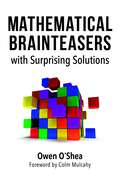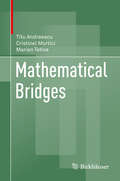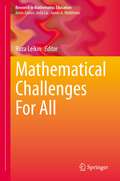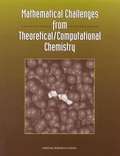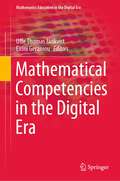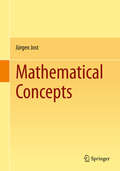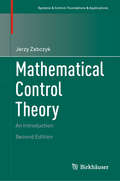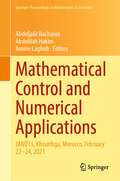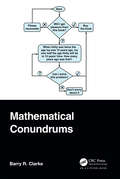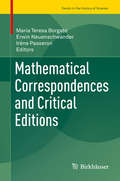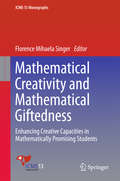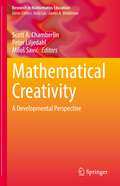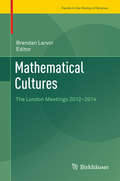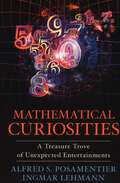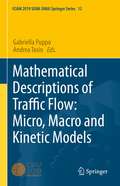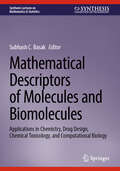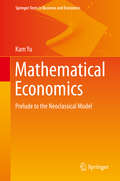- Table View
- List View
Mathematical Book Histories: Printing, Provenance, and Practices of Reading (Trends in the History of Science)
by Ciarán Mac an Bhaird Philip BeeleyThis book both articulates and responds to increasing scholarly interest in the materiality of the book. Taking as its base the unique collection of mathematical books in the Russell Library at Maynooth, it addresses questions related to printing techniques and print culture, book production, provenance, and reading practices. It considers the histories of individual items of the Russell Collection, their previous locations and owners, and explores ways in which annotations, underlinings, hand-drawn diagrams, and the like reveal patterns of reading and usage. Finally, it seeks to elicit more information on a previously under-researched topic: the historical role of mathematics in the extensive network of Irish colleges that once covered Catholic Europe, located in places such as Salamanca, Rome, Douai, and Prague. Alongside delivering important new insights into print culture as a medium for transmitting scientific ideas, Mathematical Book Histories is thus also intended to contribute to a broader understanding of the role and significance of mathematics in the context of clerical instruction and more broadly in the academic tradition of Ireland up to the beginning of the twentieth century. Many of the volumes in the Russell Library reflect the remarkably rich book-trade that flourished in seventeenth and early eighteenth century Dublin and which was quite distinct from that in London. Booksellers often bought in their wares directly from abroad, with the result that publications could enter collections that did not enter the purview of contemporary English or Scottish scholars in Britain.
Mathematical Brainteasers with Surprising Solutions
by Owen O'SheaProves that math can be serious fun! If you like any kind of game at all, you'll enjoy the amazing mathematical brainteasers in this entertaining book. No special mathematics training is needed. With an emphasis on puzzling word problems with surprising solutions, the author presents his mathematical hurdles in order of increasing difficulty. Many appear deceptively simple, such as: How many quarter-inch marks are on an unusual sixteen-inch ruler? Or: If the cost of a bottle and a cork is $1.10 and the bottle costs $1.00 more than the cork, how much did the bottle alone cost? Check the answers before you decide that these are too easy. You may be surprised. Novices may want to begin with some of the teasers in the first "easy" section. More experienced math-heads may want to test their wits with the "challenging" or even the "difficult" sections (some are fiendishly difficult). Including word problems by famed mathematical puzzle geniuses Sam Loyd (1841 - 1911) and Henry Ernest Dudeney (1857 - 1930), which have entertained recreational math aficionados for more than a century, this book has something for puzzle solvers at any level. And for the math phobic, it may whet your appetite to delve into a subject you thought could only be boring.
Mathematical Bridges
by Titu Andreescu Cristinel Mortici Marian TetivaBuilding bridges between classical results and contemporary nonstandard problems, this highly relevant work embraces important topics in analysis and algebra from a problem-solving perspective. The book is structured to assist the reader in formulating and proving conjectures, as well as devising solutions to important mathematical problems by making connections between various concepts and ideas from different areas of mathematics. Instructors and motivated mathematics students from high school juniors to college seniors will find the work a useful resource in calculus, linear and abstract algebra, analysis and differential equations. Students with an interest in mathematics competitions must have this book in their personal libraries.
Mathematical Challenges For All (Research in Mathematics Education)
by Roza LeikinThis book argues that mathematical challenge can be found at any level and at every age and constitutes an essential characteristic of any mathematics classroom aimed at developing the students’ mathematical knowledge and skills. Since each mathematics classroom is heterogeneous with respect to students’ mathematical potential, quality mathematical instruction results from matching the level of mathematical challenge to different students’ potential. Thus, effective integration of mathematical challenge in the instructional process is strongly connected to the equity principle of mathematics education. In the three sections in this volume readers can find diverse views on mathematical challenges in curriculum and instructional design, kinds and variation of mathematically challenging tasks and collections of mathematical problems. Evidence-based analysis is interwoven with theoretical positions expressed by the authors of the chapters. Cognitive, social and affective characteristics of challenging mathematical activities are observed and analyzed. The volume opens new avenues of research in mathematics education, and pose multiple questions about mathematical instruction rich in mathematical challenge for all. The authors invite readers to explore and enjoy mathematical challenges at different levels.
Mathematical Challenges from Theoretical/Computational Chemistry
by Committee on Mathematical Challenges from Computational ChemistryComputational methods are rapidly becoming major tools of theoretical, pharmaceutical, materials, and biological chemists. Accordingly, the mathematical models and numerical analysis that underlie these methods have an increasingly important and direct role to play in the progress of many areas of chemistry. This book explores the research interface between computational chemistry and the mathematical sciences. In language that is aimed at non-specialists, it documents some prominent examples of past successful cross-fertilizations between the fields and explores the mathematical research opportunities in a broad cross-section of chemical research frontiers. It also discusses cultural differences between the two fields and makes recommendations for overcoming those differences and generally promoting this interdisciplinary work.
Mathematical Challenges of Zero-Range Physics: Models, Methods, Rigorous Results, Open Problems (Springer INdAM Series #42)
by Alessandro MichelangeliSince long over the decades there has been a large transversal community of mathematicians grappling with the sophisticated challenges of the rigorous modelling and the spectral and scattering analysis of quantum systems of particles subject to an interaction so much localised to be considered with zero range. Such a community is experiencing fruitful and inspiring exchanges with experimental and theoretical physicists. This volume reflects such spirit, with a diverse range of original contributions by experts, presenting an up-to-date collection of most relevant results and challenging open problems. It has been conceived with the deliberate two-fold purpose of serving as an updated reference for recent results, mathematical tools, and the vast related literature on the one hand, and as a bridge towards several key open problems that will surely form the forthcoming research agenda in this field.
Mathematical Cognition and Understanding: Perspectives on Mathematical Minds in the Elementary and Middle School Years
by Katherine M. Robinson Donna Kotsopoulos Adam K. DubéThis book focuses on elementary and middle school children’s understanding of mathematics as well as the cognitive aspects involved in the development of mathematical knowledge, skills, and understanding. Children’s success in and understanding of mathematics stem from factors beyond the mathematics curriculum. Researchers are increasingly becoming aware of the necessity to consider a complex set of variables when accounting for large individual differences in mathematics achievement. These chapters contribute to how both researchers and educators can consider the multidimensionality of skills involved in developing mathematical knowledge in the middle school years as well as to how this knowledge can be used to enhance practices in the mathematics classroom. Topics include the cognitive and spatial skills involved in mathematics knowledge, the role of motivation in mathematics learning, the neurological processes and development of children’s mathematics skills, the development of understanding of arithmetic and fraction concepts, the factors relating to children’s word problem success, and techniques to promote mathematics understanding. This book and its companion, Mathematical Teaching and Learning, take an interdisciplinary perspective to mathematical learning and development in the elementary and middle school years. The authors and perspectives in this book draw from education, neuroscience, developmental psychology, and cognitive psychology. The book will be relevant to scholars/educators in the field of mathematics education and also those in childhood development and cognition. Each chapter also includes practical tips and implications for parents as well as for educators and researchers.
Mathematical Competencies in the Digital Era (Mathematics Education in the Digital Era #20)
by Uffe Thomas Jankvist Eirini GeraniouThis book focuses on the potential interplay between two distinct, yet related paradigm shifts in mathematics education, drawing on the notion of “networking of theories” through illustrative case studies from the Danish educational system and beyond. The first paradigm shift is the massive introduction of digital technology in the teaching and learning of the subject; the second is a shift from the traditional focusing on mastering of skills and knowledge to being concerned with the possession and development of mathematical competencies. This book builds on the Danish KOM (Competencies and the Learning of Mathematics) project, which sources its description of mathematical mastery primarily on the notion of a “mathematical competency” rather than on lists of topics, concepts, and results. This allows for an overarching framework, which captures the perspectives of mathematics teaching and learning at whichever educational level. While the KOM framework does not in detail address the role of digital technologies in relation to its description of different types of mathematical competencies, etc., the chapters of this book set out to do exactly this, while in the process also drawing on a selection of other theoretical constructs and frameworks from mathematics education research. Starting with introductory chapters by key researchers in the area, the book brings forth chapters for each of the KOM framework’s eight mathematical competencies, authored by Nordic researchers in combination with international scholars. The KOM framework also operates with three types of overview and judgement, which are specifically addressed in relation to the role of digital technologies in the third part of the book. The fourth and final part of the book broadens the scene and provides chapters of a more perspective nature in relation to mathematical competencies in the digital era. The book’s preface is by Susanne Prediger.
Mathematical Concepts
by Jürgen JostThe main intention of this book is to describe and develop the conceptual, structural and abstract thinking of mathematics. Specific mathematical structures are used to illustrate the conceptual approach; providing a deeper insight into mutual relationships and abstract common features. These ideas are carefully motivated, explained and illustrated by examples so that many of the more technical proofs can be omitted. The book can therefore be used: · simply as an overview of the panorama of mathematical structures and the relations between them, to be supplemented by more detailed texts whenever you want to acquire a working knowledge of some structure · by itself as a first introduction to abstract mathematics · together with existing textbooks, to put their results into a more general perspective · to gain a new and hopefully deeper perspective after having studied such textbooks Mathematical Concepts has a broader scope and is less detailed than standard mathematical textbooks so that the reader can readily grasp the essential concepts and ideas for individual needs. It will be suitable for advanced mathematicians, postgraduate students and for scientists from other fields with some background in formal reasoning.
Mathematical Connections: A Bridge to Algebra and Geometry
by Francis J. Gardella Patricia R. Fraze Joanne E. Meldon Marvin S. WeingardenMathematical Connections is a bridge that will take you from where you are in your study of mathematics to algebra and geometry. Since topics in mathematics are connected, this course will also lead you to data analysis and probability.
Mathematical Constants II (Encyclopedia of Mathematics and its Applications #169)
by Steven R. FinchFamous mathematical constants include the ratio of circular circumference to diameter, π = 3.14 …, and the natural logarithm base, e = 2.718 …. Students and professionals can often name a few others, but there are many more buried in the literature and awaiting discovery. How do such constants arise, and why are they important? Here the author renews the search he began in his book Mathematical Constants, adding another 133 essays that broaden the landscape. Topics include the minimality of soap film surfaces, prime numbers, elliptic curves and modular forms, Poisson–Voronoi tessellations, random triangles, Brownian motion, uncertainty inequalities, Prandtl–Blasius flow (from fluid dynamics), Lyapunov exponents, knots and tangles, continued fractions, Galton–Watson trees, electrical capacitance (from potential theory), Zermelo's navigation problem, and the optimal control of a pendulum. Unsolved problems appear virtually everywhere as well. This volume continues an outstanding scholarly attempt to bring together all significant mathematical constants in one place.
Mathematical Control Theory: An Introduction (Systems & Control: Foundations & Applications)
by Jerzy ZabczykThis textbook presents, in a mathematically precise manner, a unified introduction to deterministic control theory. With the exception of a few more advanced concepts required for the final part of the book, the presentation requires only a knowledge of basic facts from linear algebra, differential equations, and calculus.In addition to classical concepts and ideas, the author covers the stabilization of nonlinear systems using topological methods, realization theory for nonlinear systems, impulsive control and positive systems, the control of rigid bodies, the stabilization of infinite dimensional systems, and the solution of minimum energy problems.This second edition includes new chapters that introduce a variety of topics, such as controllability with vanishing energy, boundary control systems, and delayed systems. With additional proofs, theorems, results, and a substantially larger index, this new edition will be an invaluable resource for students and researchers of control theory.Mathematical Control Theory: An Introduction will be ideal for a beginning graduate course in mathematical control theory, or for self-study by professionals needing a complete picture of the mathematical theory that underlies the applications of control theory.From reviews of the first edition:At last! We did need an introductory textbook on control which can be read, understood, and enjoyed by anyone. Gian-Carlo Rota, The Bulletin of Mathematics BooksIt covers a remarkable number of topics...The exposition is excellent, and the book is a joy to read. A novel one-semester course covering both linear and nonlinear systems could be given...The book is an excellent one for introducing a mathematician to control theory. Bulletin of the AMSIndeed, for mathematicians who look for the basic ideas or a general picture about the main branches of control theory, I believe this book can provide an excellent bridge to this area. IEEE Control Systems Magazine
Mathematical Control and Numerical Applications: JANO13, Khouribga, Morocco, February 22–24, 2021 (Springer Proceedings in Mathematics & Statistics #372)
by Abdeljalil Nachaoui Abdelilah Hakim Amine LaghribThis book presents some sufficient mathematical content with expressive result. The aim of JANO13 is to bring together scientists to discuss their research in all the aspects of mathematics and their applications to different scientific discipline. The main topics of the conference is partial differential equations, mathematical control, numerical analysis and computer science. The conference is interested in recent developments on numerical analysis and real applications in computer science. The latter is viewed as a dynamic branch on the interface of mathematics and informatics that has been growing rapidly over the past several decades. However, its mathematical modelling and interpretation are still not well-explained and need much more clarifications. The main contributions of this book are to give some sufficient mathematical content with expressive results. As a growing field, it is gaining a lot of attention both in media and in the industry world, which will attract the interest of readers from different scientist disciplines.
Mathematical Conundrums (AK Peters/CRC Recreational Mathematics Series)
by Barry R. ClarkeWant to sharpen your mathematical wits? If so, then Mathematical Conundrums is for you. Daily Telegraph enigmatologist, Barry R. Clarke, presents over 120 fiendish problems that will test both your ingenuity and persistence. Between these covers are puzzles in geometry, arithmetic, and algebra (there is even a section for computer programmers). And, for the smartest readers who wish to stretch their mind to its limits, a selection of engaging logic and visual lateral puzzles is included. Although no puzzle requires a greater knowledge of mathematics than the high school curriculum, this collection will take you to the edge. But are you equal to the challenge? Features High-school level of mathematics is the only pre-requisite Variety of algebraic, route-drawing, and geometrical conundrums Hints section for the lateral puzzles Warm-up excercises to sharpen the wits Full solutions to every problem Barry R. Clarke has published over 1,500 puzzles in The Daily Telegraph and has contributed enigmas to New Scientist, The Sunday Times, Reader’s Digest, The Sunday Telegraph, and Prospect magazine. His book Challenging Logic Puzzles Mensa has sold over 100,000 copies. As well as a PhD in Shakespeare Studies, Barry has a master’s degree and academic publications in quantum physics. He is now working on a revised theory of the hydrogen atom. Other skills include mathematics tutor, filmmaker, comedy-sketch writer, cartoonist, computer programmer, and blues guitarist! For more information please visit http://barryispuzzled.com.
Mathematical Conversations: Multicolor Problems, Problems in the Theory of Numbers, and Random Walks
by E. B. Dynkin V. A. UspenskiiCombining three books into a single volume, this text comprises Multicolor Problems, dealing with several of the classical map-coloring problems; Problems in the Theory of Numbers, an elementary introduction to algebraic number theory; and Random Walks, addressing basic problems in probability theory.The book's primary aim is not so much to impart new information as to teach an active, creative attitude toward mathematics. The sole prerequisites are high-school algebra and (for Multicolor Problems) a familiarity with the methods of mathematical induction. The book is designed for the reader's active participation. The problems are carefully integrated into the text and should be solved in order. Although they are basic, they are by no means elementary. Some sequences of problems are geared toward the mastery of a new method, rather than a definitive result, and others are practice exercises, designed to introduce new concepts. Complete solutions appear at the end.
Mathematical Correspondences and Critical Editions (Trends in the History of Science)
by Maria Teresa Borgato Erwin Neuenschwander Irène PasseronMathematical correspondence offers a rich heritage for the history of mathematics and science, as well as cultural history and other areas. It naturally covers a vast range of topics, and not only of a scientific nature; it includes letters between mathematicians, but also between mathematicians and politicians, publishers, and men or women of culture. Wallis, Leibniz, the Bernoullis, D'Alembert, Condorcet, Lagrange, Gauss, Hermite, Betti, Cremona, Poincaré and van der Waerden are undoubtedly authors of great interest and their letters are valuable documents, but the correspondence of less well-known authors, too, can often make an equally important contribution to our understanding of developments in the history of science. Mathematical correspondences also play an important role in the editions of collected works, contributing to the reconstruction of scientific biographies, as well as the genesis of scientific ideas, and in the correct dating and interpretation of scientific writings. This volume is based on the symposium “Mathematical Correspondences and Critical Editions,” held at the 6th International Conference of the ESHS in Lisbon, Portugal in 2014. In the context of the more than fifteen major and minor editions of mathematical correspondences and collected works presented in detail, the volume discusses issues such as • History and prospects of past and ongoing edition projects, • Critical aspects of past editions, • The complementary role of printed and digital editions, • Integral and partial editions of correspondence, • Reproduction techniques for manuscripts, images and formulae, and the editorial challenges and opportunities presented by digital technology.
Mathematical Creativity and Mathematical Giftedness: Enhancing Creative Capacities In Mathematically Promising Students (ICME-13 Monographs)
by Florence Mihaela SingerThis book discusses the relationships between mathematical creativity and mathematical giftedness. It gathers the results of a literature review comprising all papers addressing mathematical creativity and giftedness presented at the International Congress on Mathematical Education (ICME) conferences since 2000. How can mathematical creativity contribute to children’s balanced development? What are the characteristics of mathematical giftedness in early ages? What about these characteristics at university level? What teaching strategies can enhance creative learning? How can young children’s mathematical promise be preserved and cultivated, preparing them for a variety of professions? These are some of the questions addressed by this book. The book offers, among others: analyses of substantial learning environments that promote creativity in mathematics lessons; discussions of a variety of strategies for posing and solving problems; investigations of students’ progress throughout their schooling; and examinations of technological tools and virtual resources meant to enhance learning with understanding. Multiple perspectives in the interdisciplinary fields of mathematical creativity and giftedness are developed to offer a springboard for further research. The theoretical and empirical studies included in the book offer a valuable resource for researchers, as well as for teachers of gifted students in specialized or inclusive settings, at various levels of education.
Mathematical Creativity: A Developmental Perspective (Research in Mathematics Education)
by Peter Liljedahl Miloš Savić Scott A. ChamberlinThis book is important and makes a unique contribution in the field of mathematics education and creativity. The book comprises the most recent research by renowned international experts and scholars, as well as a comprehensive up to date literature review. The developmental lens applied to the research presented makes it unique in the field. Also, this book provides a discussion of future directions for research to complement what is already known in the field of mathematical creativity. Finally, a critical discussion of the importance of the literature in relation to development of learners and accordingly pragmatic applications for educators is provided. Many books provide the former (2) foci, but omit the final discussion of the research in relation to developmental needs of learners in the domain of mathematics. Currently, educators are expected to implement best practices and illustrate how their adopted approaches are supported by research. The authors and editors of this book have invested significant effort in merging theory with practice to further this field and develop it for future generations of mathematics learners, teachers and researchers.
Mathematical Cultures
by Brendan LarvorThiscollection presents significant contributions from an international network project on mathematicalcultures, including essays from leading scholars in the history and philosophyof mathematics and mathematics education. Mathematicshas universal standards of validity. Nevertheless, there are local styles inmathematical research and teaching, and great variation in the place ofmathematics in the larger cultures that mathematical practitioners belong to. The reflections on mathematical cultures collected in this book are of interestto mathematicians, philosophers, historians, sociologists, cognitive scientistsand mathematics educators.
Mathematical Curiosities: A Treasure Trove of Unexpected Entertainments
by Alfred S. Posamentier Ingmar LehmannAn innovative and appealing way for the layperson to develop math skills—while actually enjoying it Most people agree that math is important, but few would say it's fun. This book will show you that the subject you learned to hate in high school can be as entertaining as a witty remark, as engrossing as the mystery novel you can't put down—in short, fun! As veteran math educators Posamentier and Lehmann demonstrate, when you realize that doing math can be enjoyable, you open a door into a world of unexpected insights while learning an important skill. The authors illustrate the point with many easily understandable examples. One of these is what mathematicians call the "Ruth-Aaron pair" (714 and 715), named after the respective career home runs of Babe Ruth and Hank Aaron. These two consecutive integers contain a host of interesting features, one of which is that their prime factors when added together have the same sum. The authors also explore the unusual aspects of such numbers as 11 and 18, which have intriguing properties usually overlooked by standard math curriculums. And to make you a better all-around problem solver, a variety of problems is presented that appear simple but have surprisingly clever solutions. If math has frustrated you over the years, this delightful approach will teach you many things you thought were beyond your reach, while conveying the key message that math can and should be anything but boring.
Mathematical Descriptions of Traffic Flow: Micro, Macro and Kinetic Models (SEMA SIMAI Springer Series #12)
by Andrea Tosin Gabriella PuppoThe book originates from the mini-symposium "Mathematical descriptions of traffic flow: micro, macro and kinetic models" organised by the editors within the ICIAM 2019 Congress held in Valencia, Spain, in July 2019. The book is composed of five chapters, which address new research lines in the mathematical modelling of vehicular traffic, at the cutting edge of contemporary research, including traffic automation by means of autonomous vehicles. The contributions span the three most representative scales of mathematical modelling: the microscopic scale of particles, the mesoscopic scale of statistical kinetic description and the macroscopic scale of partial differential equations.The work is addressed to researchers in the field.
Mathematical Descriptors of Molecules and Biomolecules: Applications in Chemistry, Drug Design, Chemical Toxicology, and Computational Biology (Synthesis Lectures on Mathematics & Statistics)
by Subhash C. BasakThis book provides an up-to-date overview of data driven and evidence-based empirical approaches in the efficient application of chemodescriptors and biodescriptors. Currently there is a steady increase in the use of data analytics and model-based decision support systems in basic and applied research in chemoinformatics, bioinformatics, pharmaceutical drug design, predictive toxicology, and computational biology. Since there are a plethora of modeling methods and a large number of chemodescriptors and biodescriptors available today, robust statistical and machine learning methods are applied throughout. In addition, the development of statistically robust predictive models in rank deficient cases using chemodescrip tors and biodescriptors is discussed. Readers are provided with an up-to-date overview of the theoretical background, calculation methods, and proper use of chemodescriptors and biodescriptors in model building, with special emphasis on computer-assisted organic synthesis, new drug discovery, hazard assessment of chemicals, and computational biology of emerging global pathogens. The book also discusses the applications of alignment-free sequence descriptors (AFSDs) in vaccine design and the characterization of emerging global pathogens such as the Zika virus and SARS-CoV-2. The utility of molecular fragment-based descriptors in building useful quantitative structure-activity relationship (Q)SAR) models is detailed as is the use of mathematical structural descriptors in chemical synthesis planning.
Mathematical Economics
by Arsen MelkumianThis textbook, designed for a single semester course, begins with basic set theory, and moves briskly through fundamental, exponential, and logarithmic functions. Limits and derivatives finish the preparation for economic applications, which are introduced in chapters on univariate functions, matrix algebra, and the constrained and unconstrained optimization of univariate and multivariate functions. The text finishes with chapters on integrals, the mathematics of finance, complex numbers, and differential and difference equations. Rich in targeted examples and explanations, Mathematical Economics offers the utility of a handbook and the thorough treatment of a text. While the typical economics text is written for two semester applications, this text is focused on the essentials. Instructors and students are given the concepts in conjunction with specific examples and their solutions.
Mathematical Economics: Prelude to the Neoclassical Model (Springer Texts in Business and Economics)
by Kam YuThis textbook provides a one-semester introduction to mathematical economics for first year graduate and senior undergraduate students. Intended to fill the gap between typical liberal arts curriculum and the rigorous mathematical modeling of graduate study in economics, this text provides a concise introduction to the mathematics needed for core microeconomics, macroeconomics, and econometrics courses. Chapters 1 through 5 builds students’ skills in formal proof, axiomatic treatment of linear algebra, and elementary vector differentiation. Chapters 6 and 7 present the basic tools needed for microeconomic analysis. Chapter 8 provides a quick introduction to (or review of) probability theory. Chapter 9 introduces dynamic modeling, applicable in advanced macroeconomics courses. The materials assume prerequisites in undergraduate calculus and linear algebra. Each chapter includes in-text exercises and a solutions manual, making this text ideal for self-study.
Mathematical Elegance: An Approachable Guide to Understanding Basic Concepts
by Steven GoldbergThe heart of mathematics is its elegance; the way it all fits together. Unfortunately, its beauty often eludes the vast majority of people who are intimidated by fear of the difficulty of numbers. Mathematical Elegance remedies this. Using hundreds of examples, the author presents a view of the mathematical landscape that is both accessible and fascinating. At a time of concern that American youth are bored by math, there is renewed interest in improving math skills. Mathematical Elegance stimulates students, along with those already experienced in the discipline, to explore some of the unexpected pleasures of quantitative thinking. Invoking mathematical proofs famous for their simplicity and brainteasers that are fun and illuminating, the author leaves readers feeling exuberant-as well as convinced that their IQs have been raised by ten points. A host of anecdotes about well-known mathematicians humanize and provide new insights into their lofty subjects. Recalling such classic works as Lewis Carroll's Introduction to Logic and A Mathematician Reads the Newspaper by John Allen Paulos, Mathematical Elegance will energize and delight a wide audience, ranging from intellectually curious students to the enthusiastic general reader.

